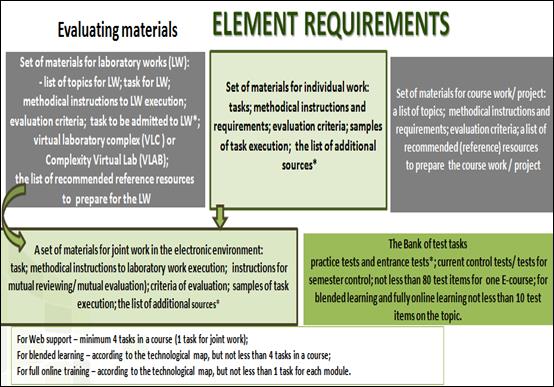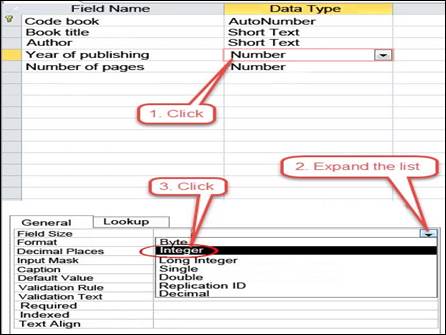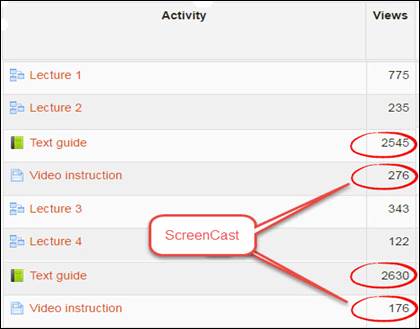Abstract
This paper investigates experience relating to the distance education in technology by means of e-learning courses as the most resource-efficient method to provide quality education. Training content of the E-learning course consists of basic and additional theoretic materials, practice tasks etc. and it can be implemented with the help of various tools. This paper is focused on the analysis of different tools in e-learning courses for practical training such as Screen cast (mp4 video), info graphic guidelines, records of webinars. The article evaluates the cost effectiveness of these tools both in costs for training production (content wrapping) and learning by the students. Resource efficiency was evaluated for the following: work input, staff time, value, relevance of the e-learning course’s tools for students, and academic progress of the students. The practice-oriented E-learning courses and LMS Moodle as a special educational environment are the most resource-efficient approaches to provide a distance teaching process.
Keywords: Cost-effectivenessdistant technologiese-learning coursesformats of the training content presentation
Introduction
Electronic training (ET) is one of the most fast developing sectors of the international educational space. It is these technologies that first of all are expected to change the training process in the nearest future. This situation can be explained by many reasons. They include: development of post-industrial information society, which is characterized by the total use of technologies integrated in all spheres and developed on the basis of information-communication technologies (ICT); free exchange of the knowledge and information; opportunities not limited only by training of highly professional specialists but capable of resolving numerous social issues aimed at enhancement of access to education and professional development throughout the whole life; efficiency enhancement for teachers and students. The leading universities meet this contemporary challenges implementing leadership strategy in ET, which allows reducing educational overexpeditures and enhance the education quality.
Nowadays, the open education role and the use of distant training technologies are growing up (Bates, 2005; Roden, 2001). Tomsk Polytechnic University has the established system of distant training which is one of the cost-effective technologies of the modern training in the university. Digital training resources make up important elements of distant education.
Methods
Development and using university digital training resources when running educational programme at all training levels including extended professional education require creation of the quality assessment system for training content of electronic courses. General criteria for quality assessment of digital electronic resources are not fully worked out in the Russian educational system. There is an open discussion between leading universities, specialists, teachers, public organisation, e.g. (International conference on New Educational technologies, 2016), and the best solution is being searched for.
The effectiveness of distance learning depends on a number of factors, including e-course as a means of its realization: «The barriers, as they see them, with no empirical basis, are; administration procedures, functionality of e-learning systems; instruction (bad instructional and content design); and interaction among participants. For them an e-learning resource is successful when: students use, and enjoy using the resource, students find the resource enriching and helpful, and educators find that the introduction of the resource promotes higher learning. Multiple case study design to investigate their hypothesised six critical success factors; technical competency (instructors and students), human factors (instructor's effort and motivational skills), both instructor's and student's having a commitment to a constructivist model of learning, encouragement to collaborate online; and finally a perception of good information technology infrastructure and support» (Turner, 2010).
The introduction of EC into training enhances training efficiency due to creation of the manageable and automated system of the knowledge assessment, implementation of the individual educational trajectory (including students trained within academic exchange programmes and individual plans, students failing to pass exams, and for the purposes of inclusive training) etc.
Results
Experience of Tomsk Polytechnic University
Tomsk Polytechnic University uses the experience of international universities as a basis, and when developing EC, these universities utilize principles of communicativeness, interaction, didactic feasibility etc. Such approach allowed creating the structure of EC complying all the requirements of the modern educational process and being suitable for all implemented forms (full-time and distant training) and education models (training with web support, mixed and distant one) (Vorobjeva, 2016; Allen, 2016).
The university is constantly working on improving the requirements for the structure and elements of the e-course. Monitoring student and teacher satisfaction resource quality and the quality of implementation of distance learning optimizes the production of teaching materials and improves resource efficiency of the educational process (Dorofeeva, 2016).
Quality requirements to the development of electronic courses adopted by TPU can be divided into three groups: content and methods; design and ergonomics; technology and process; they include the whole list of quantitative and qualitative parameters for evaluation of the completed electronic course. And the teacher during training process within a certain discipline can choose the most effective tools and services of LMS Moodle to solve the training tasks.
Distance learning should compensate to the student the unavailability of direct communication with the teacher. Therefore, it involves serious methodological elaboration of the content and presentation of its ergonomic shape. It is important in assessing the resources section which includes toolkits for all kinds of practical activities, provided by the curriculum of discipline (course work, laboratory work, individual work, etc.), to place all the necessary elements (see fig.

On the one hand, the way of representation of the training materials for them is demanded by the students having distant training within electronic practice-oriented training; and on the other hand, to be efficient for the student and for the teacher is necessary for evaluation of the training efficiency. There is large diversity of training materials representation in the electronic course: from a multipage electronic textbook to a high tech content, e.g. in the format of professional video lectures (Gikandi, Morrowa, & Davis, 2011; Jones, & Issroff, 2007).
Basing on the rich training experience in the distant education system, the authors conducted the experiment and found out which forms of the training materials presentation are the most effective in the practice-oriented electronic course, out of the row of the most available ones for the teacher.
Two groups of the students having different training forms participated in the experiment.
Group D included 141 active students taking fully distant training course (active means students accessing the electronic course at least once). Students performing electronic tasks consulted the teacher only online. The final assessment was in the online format.
Group Z included 53 active students having distant training with offline final assessment. Students from this group performed some tasks distantly in the electronic form. At the end of semester, during two weeks, there were offline session including lectures and practical training with the teacher ended by final exams.
Duration of training was the same in both groups and made up 18 weeks.
Students had the course on Information Technology aimed at training of students of humanitarian disciplines. Apart from theoretical materials, the electronic course contained the number of individual tasks and tasks for joint work aimed at the software studying.
The following formats were used for practical training materials:
The screen cast (mp4 video) explaining the main stages of work with much detail,
Guidelines in the infographic form,
Records of webinars demonstrating the stages of laboratory work.
Training materials for the first task were prepared only in the format of screencast and webinar video records. The remaining exercises were provided with infographic guidelines.
Statistical analysis of data collected by the management system about the access to certain resources allowed concluding that screencasts were more popular compared to webinar records. It might be related to some specific features of the screencast. Its duration in this course made up less than 20 minutes, and it was the advantage of this format compared to 45 minutes of the webinar record.
Also the access to webinars within this course was extremely low and it made this form of the training materials representation the least effective. It confirms again the idea that long running video training materials are poorly mastered by students and their production costs are fairly high (Bassili, 2008).
Preparing training materials in the infographic form (Fig.

Further evaluation of the training materials representation format was based on two parameters:
Demand for the resources by students.
Efficiency of the popular training materials which was assessed through the academic progress of students using the relevant training materials.
Analyzing
Analyzing the statistics of access to the electronic course elements (Fig.
compilation of scenario,
screencast record,
editing the record.
And the last stages of screencast production would require the teacher to possess the relevant skills, have the software and experience how to operate this software.

Fig.
Table
Conclusion
Thus, the article reviews the cost effectiveness of three tools popular among the teachers both from the point of view of costs for training production (content wrapping) and from the position of efficiency of training materials mastering by the student.
It is worth mentioning that labor costs of the teacher developing the course significantly differ when working out these formats of training materials: the lowest labor costs are required for infographics development allowing a significant reduction of the guidelines' volume (compared to full text guidelines) and the time for its production (compared to the record and editing of the screencast). And the highest labor costs are required to prepare and run a webinar and, given low interest towards it (low access) in students, this form of training materials presentation is the least effective.
Efficiency of training materials presentation was evaluated as per two parameters: demand for resources in students; academic progress of the students who used the above-mentioned training materials. It has been detected that webinar records were less popular in the students, and brief infographic materials were the most popular; and no relation was found between the training materials format and academic progress of the students.
Thus, the practice-oriented electronic course being a special education tool is one of the elements of implementation of the cost-effective approach to the training organisation in the distant format.
References
- Allen, М. (2016). Guide to E-Learning: Building Interactive, Fun, and Effective Learning Programs for Any Company. Alpina Publisher.
- Bassili, J. N. (2008). Motivation and Cognitive Strategies in the Choice to Attend Lectures or Watch Them Online. Journal of Distance Education, 22(3), 129–148.
- Bates, A. W. (2005). Technology, e-learning and distance education. New York: Routledge Falmer.
- Dorofeeva, M. U. (2016). Practical application of blended learning in higher education institution EDULEARN16. 8th annual International Conference on Education and New Learning Technologies. Barcelona, 7852-7858.
- Gikandi, J.W., Morrowa, & D. Davis, N. A. (2011). Online formative assessment in higher education: A review of the literature, Computers & Education, 57(4), 2333-2351.
- http://www.eric.ed.gov.ezproxy.library.wwu.edu/PDFS/ED522014.pdf [last accessed 9th December 2016].
- International conference on New Educational technologies (2016). EDCRUNCH Learn. Connect. Moscow. Available at: http://edcrunch.ru [last accessed 9th December 2016].
- Jones, A., & Issroff, K. (2007). Learning technologies: Affective and social issues. In G. Conole & M. Oliver (Eds.). Contemporary perspectives in e-learning research: Themes, methods and impact on practice. (pp. 190-202). London: Routledge.
- Roden, K. (2001). Technology in Education. University of West Alabama. Available at:
- Turner, M. J. (2010). The experience of e-learning for eight education professionals undertaking an online course in educational testing: an interpretative phenomenological analysis. A thesis submitted in of the requirements of the University of East London for the degree of Professional Doctorate in Educational and Psychology, 213.
- Vorobjeva, L. V. (2016). Approaches to electronic course design in the modern technical university. 16th International Multidisciplinary Scientific GeoConference and EXPO SGEM 201, 5. 755-763.
Copyright information

This work is licensed under a Creative Commons Attribution-NonCommercial-NoDerivatives 4.0 International License.
About this article
Publication Date
20 July 2017
Article Doi
eBook ISBN
978-1-80296-025-9
Publisher
Future Academy
Volume
26
Print ISBN (optional)
Edition Number
1st Edition
Pages
1-1055
Subjects
Business, public relations, innovation, competition
Cite this article as:
Vorobjeva, L. V., Isaeva, E. V., Serebrenninkova, A. N., & Sitnikova, O. V. (2017). Distant Technologies as Cost Effective Way of Teaching. In K. Anna Yurevna, A. Igor Borisovich, W. Martin de Jong, & M. Nikita Vladimirovich (Eds.), Responsible Research and Innovation, vol 26. European Proceedings of Social and Behavioural Sciences (pp. 1002-1008). Future Academy. https://doi.org/10.15405/epsbs.2017.07.02.129

